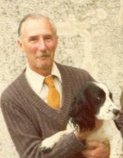Lord Forbes Bailies of Bennachie Guardian from 1996-2013
March 2013

Press Release by The Herald
Lord Forbes by GORDON CASELY
Parliamentarian, clan chief and premier baron of Scotland;
Born: February 19, 1918; Died: March 5, 2013.
Lord Forbes, who has died aged 95, was premier baron of Scotland and possibly the last survivor of Scotland's Representative Peers. Such nobles formed a uniquely Scottish institution, dating from the Treaty of Union of 1707 when Scotland's peers elected 16 of their number to sit in the Lords. In recognition of this, the group were entitled to use the post-nominal "RP" – until their offices were abolished in the Peerage Act of 1963.Born into a family whose recorded lineage goes back to a charter of 1271 from King Alexander III, Nigel Ivan Forbes, 22nd Lord Forbes, was both a pillar of Aberdeenshire life and a disciplined parliamentarian. His maiden speech in the Lords in 1955 took as a courageous theme the necessity for a road bridge over the Firth of Forth. In those days, this was a touchy subject, perceived as a somewhat romantic issue championed by the likes of historical novelist Nigel Tranter and the tiny Scottish National Party. Nevertheless, a completed bridge was opened eight years later.
As a working peer, Lord Forbes played to his constitutional strengths in education, home affairs and particularly country matters. On this last, one of his final active roles in the Lords was in April 1996 when he spoke on the Deer (Scotland) Bill.He gained ministerial office in Harold Macmillan's government when appointed Minister of State at the Scottish Office under Secretary of State for Scotland Jack Maclay (later Viscount Muirshiel), Lord Forbes replacing Lord Strathclyde, grandfather of the present Strathclyde.
The complete Donside man, Lord Forbes maintained a lifetime passion for his corner of Aberdeenshire, chief of a clan which once boasted some 150 great houses and estates of chieftains and lairds of the name in Aberdeenshire and Banffshire – so many Forbes houses that they almost bore their own ABC: Asloun, Brux, Craigievar, Druminnor, Edinglassie and so on. The involvement of Lord Forbes's forebears in Scotland's affairs has been absolute, including a notable stand at the Battle of Harlaw in 1411 against Donald, Lord of the Isles.Life might have treated Forbeses better had they and the House of Gordon and clan Leslie not engaged in centuries-long feuds involving two battles and several massacres. It took two Acts of Parliament and a move by King James VI to force the factions to lay down their arms.Educated at Harrow and Sandhurst, Lord Forbes was commissioned into the Grenadier Guards, following in the footsteps of his father, Atholl, 21st Lord Forbes, into the Grenadier Guards and fought and was wounded at Dunkirk. He latterly was appointed a military assistant with the High Commissioner for Palestine.As the holder of an ancient Scots peerage, his title as heir to the barony was Master of Forbes, the term Master being a feature peculiar to ancient Scots peerages.
His accession to the title on the death of his father led the then Major Forbes to retire from active service to concentrate on his estates and local political life on Donside, and his home at Balforbes became a centre for family and social life.He served as chairman of the Royal Highland & Agricultural Society, was a co-founder of Grampian Television and director for nearly three decades, and used his considerable experience of business and the countryside in effective chairmanship of institutions varying from the Don fishery board to Rolawn, now the largest producer of cultivated turf in Europe.
His involvement in public affairs throughout an extraordinarily long life ranged from bearing the coronet of the Princess Royal at the 1953 Coronation to officiating at simple community events as a deputy lieutenant for Aberdeenshire. He was appointed to the county lieutenancy in 1958, and it was a matter of some pride that his elder son Malcolm, Master of Forbes, followed him as a deputy lieutenant in 1996.His erect bearing and innate courtesy saw him slide easily in formal ceremonial, but it was his natural friendliness which made him so popular at local events such as the presentation of a coat-of-arms to Rosehearty Community Council in 2000. After the formalities on that occasion, he took time to work his way round local people, speaking to Guides, schoolchildren, SWRI and the village playgroup, as well as freemasons – whose Lodge Forbes No76 is named after one of Lord Forbes's collateral ancestors. For his work in public life, he was made KBE in 1960.
Deeply interested in the countryside, he took pride in his honorary appointment to the Bailies of Bennachie, guardian volunteers of the 1800-foot hill overlooking his home.
A keen naturalist and ornithologist, Lord Forbes possessed a lifetime interest in photography. It was his interest in this subject which led to two portraits of himself forming part of the photographic collection of the National Portrait Gallery in London.
He is succeeded as 23rd Lord Forbes by his son Malcolm.